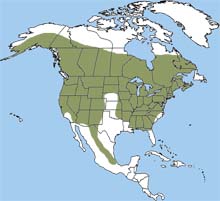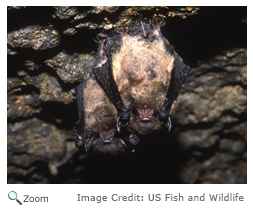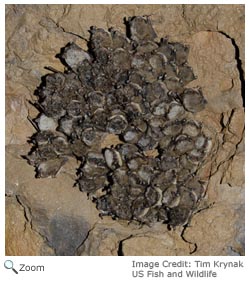Characteristics
 The little brown bat has glossy brown fur. It has hair on its toes and it has pointed ears. It is between three and five inches in length and weighs between 1/16 and 1/2 ounces. The little brown bat is also knownas the little brown myotis. The little brown bat has glossy brown fur. It has hair on its toes and it has pointed ears. It is between three and five inches in length and weighs between 1/16 and 1/2 ounces. The little brown bat is also knownas the little brown myotis.
Range
 The little brown bat is found in most of the United States and Canada, except for the south central and southeastern United States and northern Alaska and Canada.
The little brown bat is found in all parts of New Hampshire. The little brown bat is found in most of the United States and Canada, except for the south central and southeastern United States and northern Alaska and Canada.
The little brown bat is found in all parts of New Hampshire.
Habitat
The little brown bat lives along streams and lakes. It forms nursery colonies in buildings. In the winter it hibernates in caves and mines.
Diet
 The little brown bat eats insects like gnats, flies, moths, wasps and beetles. The little brown bat hunts at dusk and at night. It uses echolocation to locate prey. It sends out a high-frequency sound. When the sound hits an object, it bounces back to the bat. The bat then can identify what the sound hit and where it is. When it finds its prey, it grabs it with its wings and tucks it into a pouch formed when it brings its wing and tail membranes together. It then grabs the insect with its sharp teeth and eats it! The little brown bat eats insects like gnats, flies, moths, wasps and beetles. The little brown bat hunts at dusk and at night. It uses echolocation to locate prey. It sends out a high-frequency sound. When the sound hits an object, it bounces back to the bat. The bat then can identify what the sound hit and where it is. When it finds its prey, it grabs it with its wings and tucks it into a pouch formed when it brings its wing and tail membranes together. It then grabs the insect with its sharp teeth and eats it!
|
|
Life Cycle
Mating season is in the fall, but fertilization doesn't happen until spring. In the spring little brown bats form huge nursery colonies. A nursery colony may have thousands of bats in it. The female little brown bat gives birth to only one baby. During birth, the female hangs right-side up! The baby bat attaches itself to a teat. It nurses for about two weeks. It will fly when it is three weeks old.
Behavior
 The little brown bat migrates to caves or mines in the winter to hibernate. It wakes up every couple of weeks during hibernation. It doesn't feed when it wakes up, but it may fly around outside the cave on warm nights. The little brown bat migrates to caves or mines in the winter to hibernate. It wakes up every couple of weeks during hibernation. It doesn't feed when it wakes up, but it may fly around outside the cave on warm nights.
|